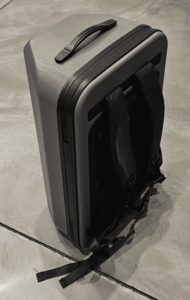There is a way to get nearly all of the supposed benefits from the validations provided in USPTO’s DOCX filing paths, while avoiding the ponderous professional liability risks of those DOCX filing paths. Continue reading “Getting the benefits of DOCX filing while avoiding the risks”
A second unanswered letter from the USPTO – DOCX safeguard
(Update: it looks like maybe the USPTO might answer my letter about this. See blog article.)
The USPTO has not yet answered a letter from ten days ago, asking about the metes and bounds of the (apparently quite limited) safeguard provided by a protective PDF accompanying a DOCX patent application. Continue reading “A second unanswered letter from the USPTO – DOCX safeguard”
A first unanswered letter from the USPTO – Patent Center EBC tickets
On October 12, 2023 I sent an email to USPTO Commissioner Udupa containing a list of fifteen EBC trouble tickets that relate to bugs in Patent Center (see email), asking her to let us know the open-or-closed status of those EBC trouble tickets. We did not hear back. This was in preparation for our in-person meeting with Commissioner Udupa about Patent Center that was going to take place on October 18. On October 17, the day before the in-person meeting, Commissioner Udupa emailed us (see email) to report that she was “completing her full review” not only of those fifteen EBC trouble tickets but also a group of 350 EBC trouble tickets relating to Patent Center, that she hoped to discuss with us the following day in the in-person meeting. During the in-person meeting, she did not provide the results of her review.
So on November 17, 2023, USPTO Commissioner Udupa received this letter. It reminded her that we still hoped to hear back from her on the status of the first fifteen EBC trouble tickets, and on the status of the 350 EBC tickets that she told us about on October 17 2023.
More than two months have passed with no response from Commissioner Udupa. Here is my conclusion, as predicted here:
If we were to fail to hear back from Commissioner Udupa in response to this letter, I think it would be reasonable to conclude that she is tacitly admitting that she was wrong when she said the EBC gets back to people about EBC tickets about Patent Center. If we were to fail to hear back from Commissioner Udupa in response to this letter, I think it would be reasonable to conclude that she is tacitly admitting that we were correct when we told her that the EBC has never, not even once, gotten back to people about EBC tickets about Patent Center.
Training and system design fails at the USPTO

It is as if the USPTO actively wishes to punish applicants for making the choice to use DAS instead of shipping a physical certified copy of a priority document. What I will now describe is a training fail for the USPTO’s Office of Patent Application Processing, along with a system design fail by the USPTO’s software developers. Continue reading “Training and system design fails at the USPTO”
Now available: training slides for son-of-EPAS/ETAS
The USPTO is apparently still planning to shut down EPAS and ETAS at 12:01 AM on Monday, February 5, 2024, and is still planning to release the successor system, called “Assignment Center” (“AC”), at that time.
The USPTO has released training slides for the patent side of AC and training slides for the trademark side of AC. The USPTO has also posted training videos.
The Trademark Office promised to shave “1-2 weeks” off the waiting time for a registration certificate
The USPTO promised in December of 2021 that the migration from paper to PDF trademark registration certificates would shave off “1-2 weeks” of the waiting time to receive the certificate. Did the USPTO keep its promise? Continue reading “The Trademark Office promised to shave “1-2 weeks” off the waiting time for a registration certificate”
Get your numbers in for the 2023 toteboards
Hello colleagues. It is time to get your numbers in for the 2023 toteboards. The toteboards have a goal of recognizing the intellectual property firms that filed the most US utility patent applications, filed the most US design patent applications, filed the most US plant patent applications, and filed the most US trademark applications, and saw them through to issuance and registration.
The submission forms will close toward the end of the day on Friday, February 9, 2024. Please don’t dawdle with this. Please just hand in your numbers and be done with it.
The 2023 toteboards will get published in February of 2024. Every year, we publish the toteboards, and after that, some firm comes in begging and pleading to hand in its numbers late. Please don’t do that. Please hand in your numbers no later than Friday, February 9, 2024!
You can see the past toteboards, including the 2022 toteboards, here.
-
- To hand in your numbers for the Ninth Annual utility patent toteboard, click here.
- To hand in your numbers for the Ninth Annual trademark toteboard, click here.
- To hand in your numbers for the Twelfth Annual design patent toteboard, click here.
- To hand in your numbers for the Fifth Annual plant patent toteboard, click here.
What exactly is the “ongoing safeguard” that the applicant gets from the “auxiliary PDF”?
(Update: it looks like maybe the USPTO might answer my letter about this. See blog article.)
Anybody who files a US utility patent application is forced to choose among three filing paths, each of which has advantages and disadvantages. The paths include:
-
- Legacy PDF. This is the path that incurs the $400 non-DOCX penalty. If you pick the legacy PDF filing path for your patent application, you can draw upon twenty years of experience with Certificate of Correction practice. If a correction of the issued US patent is needed because of a USPTO error, the path for correction is well understood and predictable.
- DOCX without applicant-generated PDF. A first filing path that permits the applicant to avoid the need to pay the non-DOCX surcharge is the filing of the patent application in DOCX format, without also filing an applicant-generated PDF. If you pick DOCX without applicant-generated PDF, it appears that there is no correction path available to the patent owner at all, except in the relatively rare case where the patent issues within one year of the application filing date.
- DOCX with applicant-generated PDF. A second filing path that permits the applicant to avoid the need to pay the non-DOCX surcharge is the filing of the patent application in DOCX format, accompanied by an applicant-generated PDF. If you pick DOCX with applicant-generated PDF, it is not very clear what correction path is available to the patent owner. One of the Federal Register notices talks about an “ongoing safeguard”, but it is not clear when a correction request may be filed (maybe only within one year of the application filing date).
 Here is a canonical list of domino clicks for adoption of NACS (Tesla-style) electric vehicle charging plugs and charging ports.
Here is a canonical list of domino clicks for adoption of NACS (Tesla-style) electric vehicle charging plugs and charging ports.
As you will see, nearly all makers of EVs for the US market have by now joined the NACS club, the sole holdout being Stellantis (maker of Alfa Romeo, Chrysler, Dodge, Jeep, Maserati, and Ram).
Dear reader, are you located in the US and do you own or lease an EV that is not a Tesla vehicle? If so, then I’d like to know where on your vehicle the charging port is located. Please visit this blog article and complete the survey to let me know where the charging port is located on your vehicle.
A blog article about a Starlink travel case

Here is a blog article, in a writing style that might look somewhat familiar, about a travel case that carries a Starlink router and antenna.
